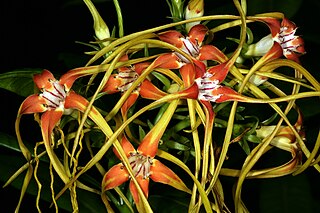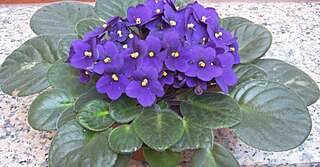
Strophanthus is a genus of flowering plants in the family Apocynaceae, first described as a genus in 1802. It is native primarily to tropical Africa, extending to South Africa, with a few species in Asia from southern India to New Guinea and southern China. The genus name is a compound of the Greek words στροφος (strophos) "twisted" and ανθοσ (anthos) "flower", in reference to the corolla lobes which, in some species - notably S. petersianus - resemble long twisted ribbons or threads and can reach a length of 30–35 cm. This trait, in addition to colouring involving combinations of bright pinks, purples and oranges, combine to make the flowers among the most ornamental in the plant kingdom.
Protomegabaria is a genus of flowering plant belonging to the family Phyllanthaceae first described as a genus in 1911. It is native to western and central Africa. It is dioecious, with male and female flowers on separate plants.
- Protomegabaria macrophylla(Pax) Hutch. - Nigeria, Cameroon, Republic of the Congo, Gabon, Gulf of Guinea Islands
- Protomegabaria meiocarpaJ.Léonard - Gabon, Democratic Republic of the Congo
- Protomegabaria stapfiana(Beille) Hutch. - West Africa

Streptocarpus sect. Saintpaulia is a section within Streptocarpus subgenus Streptocarpella consisting of about ten species of herbaceous perennial flowering plants in the family Gesneriaceae, native to Tanzania and adjacent southeastern Kenya in eastern tropical Africa. The section was previously treated as a separate genus, Saintpaulia, but molecular phylogenetic studies showed that it was nested within the genus Streptocarpus.

Eugenia capensis, the dune myrtle, is a species of plant in the family Myrtaceae, which is native to East and southern Africa.
Magnistipula is a genus of plant in family Chrysobalanaceae described as a genus in 1905.
Pararistolochia is a formerly accepted genus in the plant family Aristolochiaceae. As of March 2023, it is considered a synonym of the genus Aristolochia.
Aristolochia preussii, synonym Pararistolochia preussii, is a species of plant in the family Aristolochiaceae. It is native to Cameroon, Equatorial Guinea, Gabon, and Ivory Coast. Its natural habitat is subtropical or tropical dry forests. It was assessed as "critically endangered" and threatened by habitat loss in the 2000 IUCN Red List, where it is said to be native only to Cameroon. As of February 2023, Plants of the World Online gives it a wider distribution.

Tapinanthus is a genus of mistletoe in the family Loranthaceae, endemic to Africa. The name of the genus is derived from the Greek tapeinos meaning "low" or "humble" and anthos meaning flower.

Urobotrya is a genus of plants in the family Opiliaceae described as a genus in 1905.

Streptocarpus ionanthus is a species of Streptocarpus in the section Saintpaulia, commonly known as an African violet. It is native to eastern and southwestern Tanzania.
Syntriandrium is a genus of flowering plants belonging to the family Menispermaceae.

Rhaphiostylis is a genus of flowering plants belonging to the family Metteniusaceae.
Pierrina is a monotypic genus of flowering plants belonging to the family Lecythidaceae. It only contains one known species, Pierrina zenkeriEngl.







